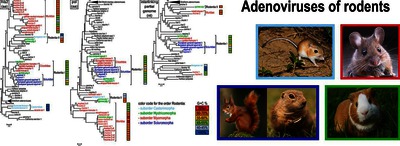Vidovszky, Márton and Kaján, Győző László and Böszörményi, Kinga P. and Podgorski, Iva I. and Doszpoly, Andor and Ballmann, Mónika Z. and Mitró, Gergő and Skoda, Gabriella and Turk, Marije and Groothuizen, Matthijs K. and Bidin, Marina and Hendrickx, Rodinde and Hemmi, Silvio and Egyed, László and Benkő, Mária and Harrach, Balázs (2025) Comprehensive phylogenetic analysis of newly detected rodent adenoviruses sheds light on ancient host-switches. MOLECULAR PHYLOGENETICS AND EVOLUTION, 204. No.-108287. ISSN 1055-7903
|
Text
2025VidovszkyetalrodentAdVsMolPhylEvol.pdf - Published Version Available under License Creative Commons Attribution. Download (1MB) | Preview |
|
![[img]](https://real.mtak.hu/223996/7.hassmallThumbnailVersion/1-s2.0-S1055790325000041-ga1_lrg%20%281%29.jpg)
|
Text (graphical abstract)
1-s2.0-S1055790325000041-ga1_lrg (1).jpg - Published Version Available under License Creative Commons Attribution. Download (142kB) | Preview |
Abstract
Here we provide a comprehensive update on the diversity and genetic relatedness of adenoviruses occurring in rodents. Extensive PCR screenings revealed the presence of adenoviral DNA in samples originating from representatives of 17 rodent species from four different suborders of Rodentia. Distinct sequences of 28 different adenoviruses were obtained from the positive samples. Out of these, 20 were from hitherto unknown, putative novel adenoviruses, whereas 6 were variants of previously published murine adenoviruses. Additionally, two known viruses, guinea pig adenovirus 1 and squirrel adenovirus 1 were also detected. By PCR and primer walking, we determined the sequence of a considerable part of the genomic DNA of squirrel adenovirus 1, detected in red squirrel (Sciurus vulgaris) samples from Germany previously. We annotated the almost complete genome sequence of a novel mastadenovirus found by data mining in the bulk data of the Ord’s kangaroo rat (Dipodomys ordii) genome project. We revisited the sequence of the gene of E1B 19 K protein of mouse adenovirus 3. In contrast to the prototype strain, where a truncated version of this gene has been found, in our sample of mouse adenovirus 3, it seemed to be intact. Based on phylogeny reconstructions, all rodent adenoviruses clustered in the genus Mastadenovirus. Interestingly, however, there wasn’t a common monophyletic clade encompassing every adenovirus of rodent origin. Instead, three major lineages were observed. Because two lineages contained viral sequences deduced from samples of three suborders, and one consisted almost exclusively of adenoviruses from the family Muridae, we hypothesize there has been a long-term coevolution with the rodent hosts, as a result of possible ancient host-switch events. Several putative viruses appeared in distinct branches further away from the three clades. Thus, the evolutionary past of the adenoviruses of rodents remains to be studied further.
| Item Type: | Article |
|---|---|
| Uncontrolled Keywords: | Rodent adenoviruses, Virus-host coevolution, Phylogeny, Virus taxonomy |
| Subjects: | Q Science / természettudomány > QL Zoology / állattan Q Science / természettudomány > QR Microbiology / mikrobiológia |
| SWORD Depositor: | MTMT SWORD |
| Depositing User: | MTMT SWORD |
| Date Deposited: | 12 Sep 2025 04:37 |
| Last Modified: | 12 Sep 2025 04:37 |
| URI: | https://real.mtak.hu/id/eprint/223996 |
Actions (login required)
 |
Edit Item |




